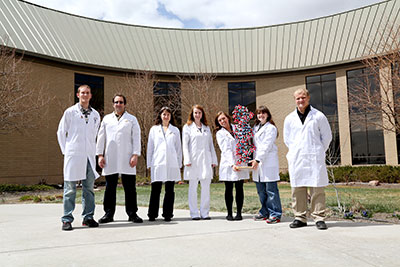New facility is 'game changer' for science programs
January 1, 2013

The new Health and Science Center significantly changes more than just the physical landscape at Central Wyoming College.
“It’s a game changer for the sciences and for the school,” Professor of Biology/Microbiology Steve McAllister said of the new building that opens this fall. “The nursing program is no longer a hidden jewel and is now on display.”
The 52,342 square foot building not only gives CWC’s nationally recognized nursing program more prominence, visitors to the campus will have a window into the science programs at the college.
Almost the entire main floor of the college’s new facility is devoted to the sciences and features six large, modern labs for the physical and life sciences, a multipurpose auditorium that will be used for large lecture classes as well as public events, and faculty office suites.
McAllister hopes to generate more interest in science, technology, engineering and math, referred to as STEM programs, with the increased visibility.
“We expect the nursing program to double in capacity over the next few years, and we need to respond,” he said, explaining all students are required to take anatomy, physiology and biology before being considered for acceptance into the nursing program. At the same time, he wants to entice more students to pursue other STEM fields.
“The biggest impact comes in the sciences,” said Health and Sciences Dean Kathy Wells.
This fall, the division begins implementing a cadaver anatomy program. Students in nursing and pre-health especially will benefit from a cadaver anatomy program, she said. Students may choose either traditional or cadaver options.
Those walking down the hall of the Health and Science Center’s first floor will have an opportunity to view faculty preparing for their labs and students working on their undergraduate research projects. The prep areas line the corridors, and also connect the teaching labs.
“The space is really well planned,” McAllister said, referring to lab support areas which allow faculty and student assistants to prepare for labs without interrupting other labs.
“It’s a building of light,” he said. There are windows in all of the instructional areas, which McAllister said is a “real luxury” because the old crowded labs had only “one tiny window” and no storage or prep space.
Prior to the construction of Health and Science, labs for different subjects were shared, making it difficult to set up and tear down labs while others labs were in session. Now there are dedicated labs for biology, physiology and anatomy. Microbiology and chemistry, earth science and geology, and physics and environmental science share the other three labs.
With the dedicated and larger labs, CWC will be able to offer additional lab sections and more students should be able to participate in undergraduate research projects. In fact, it is a goal of the science faculty to have every student experiencing undergraduate research. “With the additional infrastructure, it will be part of the curriculum,” he said.
CWC is part of the Community College Undergraduate Research Initiative (CCURI), and the science faculty plans to incorporate research into most every course using an inquiry-based teaching model where students are exposed to real world science through a case study. With the increased exposure students have in scientific inquiry, the faculty hope to pique more interest in STEM programs.
“We can provide opportunities during the freshman and sophomore years that most university students would not experience,” McAllister said.
With science and nursing faculty residing in the same space, he expects improved understanding and communication between programs. “We are already rethinking some of the content of our curriculum,” he said.
In addition to being much larger, the labs have many safety features, including eye washing stations and safety showers in each lab. Students will also have dedicated space to study in the building which complete with dramatic views of the Wind River Valley and the campus. The center should also enhance collaborative learning.